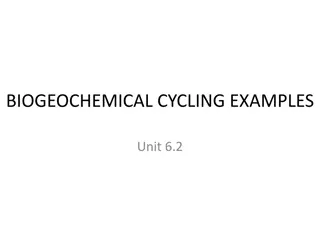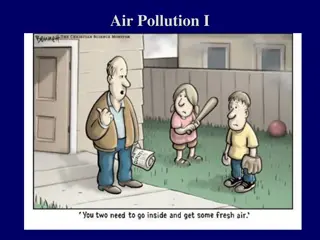Iowa Nutrient Pollution Control Measures and Strategies
Gulf Restoration Network Decision, sources of Nutrients Nitrogen (N) and Phosphorus (P), impacts of Nutrient Pollution leading to Algae Blooms and Gulf Hypoxia (Dead Zone), measures to reduce Non-Point Source (NPS) contamination, EPA's current strategy, and Iowa's approach with its Nutrient Reduction Strategy and Stream Nutrient Criteria.
Uploaded on Sep 19, 2024 | 3 Views
Download Presentation

Please find below an Image/Link to download the presentation.
The content on the website is provided AS IS for your information and personal use only. It may not be sold, licensed, or shared on other websites without obtaining consent from the author.If you encounter any issues during the download, it is possible that the publisher has removed the file from their server.
You are allowed to download the files provided on this website for personal or commercial use, subject to the condition that they are used lawfully. All files are the property of their respective owners.
The content on the website is provided AS IS for your information and personal use only. It may not be sold, licensed, or shared on other websites without obtaining consent from the author.
E N D
Presentation Transcript
Nutrients Nitrogen (N) Phosphorus (P) Sources include: NPS: fertilizer/manure runoff, septic tank overflow Point sources: municipal/industrial wastewater
2004 USDA/IDNR Study Measures to reduce NPS N and P existing conservation practices can significantly reduce NPS N and P contamination of surface waters. Most notable among these practices are cover crops (50% for TN and TP), diverse cropping systems (50% for TN and TP), in-field vegetative buffers (25% TN, 50% TP), livestock exclusion from stream and riparian areas (30% TN, 75% TP), and riparian buffers (40% TN, 45% TP). Other practices that offer appreciable reductions in NPS TN loss are N nutrient timing and rate conservation management (15-60%) and wetlands (30%). Additional practices that also can significantly reduce NPS TP loss are moderately reduced tillage practices (50% compared to intensive tillage) and no-tillage (70% compared to intensive tillage, 45% compared to moderately reduced tillage), terraces (50%), seasonal grazing (50%), and P nutrient knife or injection application (35%).
EPA Partnership Memo 2011 more effective more efficient
EPA Partnership Memo 2011 States should:
Iowas approach The March 2013 Iowa Nutrient Reduction Strategy Near-term: implementation of technology-based nutrient controls and practices long-term goal: development of appropriate nutrient criteria
Stream Nutrient Criteria TAC August 2013 Draft report: This report summarizes work completed to-date seeking to determine levels of nutrients and nutrient response parameters that are protective of Iowa s stream biological assemblages and designated aquatic life uses. Through a review of technical and scientific literature and the analysis of monitoring data from Iowa streams, this project attempted to identify benchmark values that can serve as a foundation for establishment of nutrient enrichment criteria.
Gulf Restoration Network case July 2008: coalition of 11 environmental groups (including Iowa Envt l Council and Sierra Club) filed a petition for rulemaking with EPA. Petition requested that EPA set federal numeric standards for N and P. At least for Gulf of Mexico, Mississippi River, and tributaries Preferably, for all state waters that do not have numeric standards now
Clean Water Act Although states have primary authority to set water quality standards, Section 303(c)(4) provides: [EPA] shall promptly prepare a revised or new water quality standard in any case where [EPA] determines that a revised or new standard is necessary to meet the requirements of this chapter. where [EPA] determines that a revised or new standard is necessary
EPA Denial of Petition EPA denied the petition July 2011 (i.e., 3 years later): Rulemaking not most practical or effective way to deal with N/P Continue to work co-operatively with states/tribes RM: highly resource/time intensive and would then require sizable regulatory/oversight burden Not foreclosing possibility that federal numeric nutrient criteria might be necessary in the future.
Gulf Restoration Network suit Challenged denial as improper Court decision: Friday, September 20, 2013 EPA claimed decision not reviewable by court, because it was discretionary. Court rejected that claim, finding that discretion was limited. 2. Statute requires EPA to base its denial decision on the grounds provided by the statute: 1. - i.e., whether numeric nutrient standards are necessary - instead EPA said they preferred to use a different approach
Precedent: Mass. v. EPA Rulemaking petition for EPA to regulate greenhouse gas as air pollutant under Clean Air Act. EPA declined, citing pragmatic reasons U.S. Supreme Court held that EPA must based its decision on the standard provided in the statute, not on external factors
Result Gulf Restoration court remanded to EPA ordering the agency to respond to the rulemaking petition within 180 days. EPA must make a necessity determination = must determine whether numeric nutrient criteria are necessary to meet requirements of Clean Water Act.
On remand necessity determination Court refused to limit this determination to scientific data because CWA puts primary responsibility for WQS on states, EPA could consider wider range of considerations in making necessity decision. including the very factors that [EPA] cited in the Denial.
Possible outcomes EPA could appeal to court of appeals EPA could make respond to petition within six months: Denial: no federal standards necessary because state efforts are proceeding and will ultimately solve problem Grant: based on numerous statements in past that numeric standards are necessary and states are not moving fast enough to adopt them























